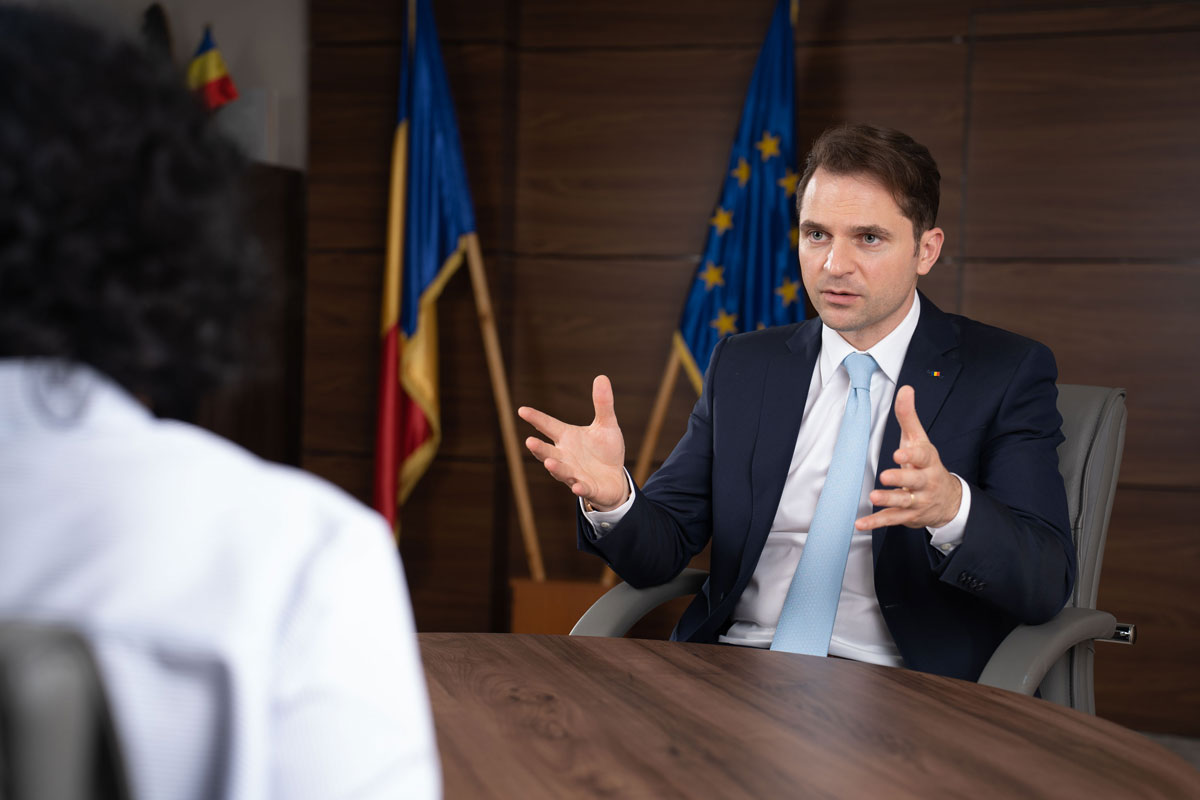Sebastian-Ioan Burduja, Minister of Energy: Romania’s Role in Enhancing Energy Security in the Region
In an in-depth conversation, Romania’s new Minister of Energy Sebastian-Ioan Burduja reveals the Government’s plans for a sustainable energy development, but also speaks of Romania’s role in enhancing energy security and stability in the region.
Sebastian Burduja is currently Minister of Energy in the Government of Romania, after he previously served as Minister of Research, Innovation, and Digitalization. He holds a PhD in economics (Summa Cum Laude, ASE Bucharest), a master’s degree in business administration (MBA) from Harvard Business School, and a master’s degree in public policy (MPP) from Harvard Kennedy School of Government. He graduated from Stanford University with special honours and distinction.
Between 2012 and 2016 he worked as a Regional Development Expert at the World Bank in Washington D.C. Previously, he was a consultant for Dalberg Global Development Advisors, a strategic consulting firm specialized in international development.
Dear Mr. Sebastian Burduja, at the beginning of your mandate, what are your top objectives regarding the energy sector? What do you intend to add to your agenda this year?
Sebastian-Ioan Burduja: I have a one-track mind: investments, investments, investments. Not a day goes by without a serious conversation with my team at the Ministry of Energy, and there is always a running theme: how fast can we do it? Romania’s about to begin a revolution in the energy sector, boosting a smart transition into a future that is secure, competitive, and green – and the order is no coincidence.
This requires developing diverse sources of energy for both electricity and gas, while modernizing the grid and maintaining its balance. To be sure, this is no easy task. As we accommodate more and more green energy from wind and solar, with intermittent production, while we embark on one of the most ambitious plans for removing coal from our energy mix, we have to find alternative sources for baseload production (gas, nuclear), as well as to accelerate pumped-storage projects and investments into batteries.
At the same time, we do not want to leave anyone behind. The large coal-based producers mean jobs for thousands of Romanians. We need to identify concrete solutions for all of them and provide hope for a better, cleaner future.
To accomplish everything, we do have close to 18 billion euros from the Recovery and Resilience Facility (RRF) and the Modernization Fund. It is time to put these funds to work, accelerate RRF implementation and meet all pending milestones, and simply deliver against the very high hopes and expectations of our energy sector.
As a former Minister of Research, Innovation and Digitalization, how do you assess these topics within the Ministry of Energy?
Sebastian-Ioan Burduja: I do believe in the 3D model for our energy sector: decarbonisation, decentralization, digitalization. Romania is behind on all three, but I have every intention to catch up and move ahead of other countries. Digitalization implies resilience, cost efficiencies, and better management of our energy sector based on measurable and continuously updated data. On the research side, I am proud to support the ALFRED project, a 4th generation led-based nuclear reactor demonstrator, one of the world’s most ambitious civil nuclear research projects.

What are the most important strategic domestic/regional projects the Energy Ministry is involved in for the time being and in the coming year?
Sebastian-Ioan Burduja: In the pursuit of a sustainable and thriving energy sector, the Ministry of Energy is actively engaged in several strategic projects. These initiatives aim to enhance energy supply, modernize infrastructure, promote regional cooperation, and strengthen energy efficiency.
- Clean Energy: the ministry is driving the expansion of clean energy sources such as solar, wind, hydroelectric, and nuclear power. We are enabling over 5GW of investments in renewables through RRF and the CfD scheme, in nuclear we support units 1 (refurbishing) and units 3 and 4 (new), and small modular reactors. And we are driving forward with our pumped-storage hydroelectric project in Transylvania, Tarnita-Lapustesti.
- Grid Modernization: Ensuring a reliable and robust power grid is essential. The ministry is investing in modernizing the electricity transmission and distribution infrastructure to improve efficiency, reduce losses, and accommodate the integration of renewable energy sources.
- Cross-Border Energy Projects: In line with promoting regional cooperation, the ministry is actively engaged in cross-border energy projects. These initiatives include interconnection of power grids with neighbouring countries, fostering energy trade, and harmonizing regulations to establish a regional energy market. A special initiative is the Green Corridor, with Azerbaijan, Georgia, and Hungary, based on direct current technology.
- Energy Efficiency Initiatives: the ministry is focused on promoting energy efficiency across various sectors. Through energy audits, awareness programs, and incentives, the ministry aims to reduce energy consumption, increase productivity, and minimize carbon emissions, particularly for private sector actors.
Looking ahead, we plan to continue our efforts in these strategic projects and further collaborate with stakeholders, both domestically and regionally. By prioritizing sustainability and innovation, the ministry aims to ensure a reliable, affordable, and environmentally-friendly energy sector in the coming year and beyond.
Currently, the energy sector in Romania is stable and benefits from a balanced mix of resources. Yet, there are still some shortcomings due to an old issue – the lack of investments in this field. What priority measures to improve this situation do you see and what segments of the industry have pressing needs?
Sebastian-Ioan Burduja: Considering the current international context, it is essential that all states make the best use of all sources and technologies available at the national level in the energy sector – local resources, nuclear capacities, and localized supply chains. At the same time, there is also a need for massive investments in renewable energy sources, as well as the modernization of the grid.
In the National Recovery and Resilience Plan (NRRP), Romania is considering investments in new production capacities of 950 MW of electricity from renewable sources (onshore solar and wind), with an allocation of 460 million euro.
To stimulate renewable energy production, the Ministry of Energy has under development a Contracts for Difference (CfD) mechanism for all low-carbon technologies, as the main instrument to encourage investment in new energy generation capacities based on clean technologies. The purpose of such a mechanism is to ensure predictability for investors in making investments in low-carbon technologies, the beneficiaries of the CfD support mechanism having the certainty of obtaining a certain level of income that guarantees the recovery of the initial investment.
Given the need to achieve the ambitious targets that will be established in the revised National Integrated Plan for Energy and Climate Change (PNIESC) and considering the need to accelerate the replacement of phased-out coal capacities, the Ministry of Energy is negotiating with the European Comission a state aid scheme for 5 GW renewables (onshore wind and solar) under the CfD mechanism, with the Modernisation Fund to be used to ensure the necessary Liquidity Fund for the mechanism. Two bidding rounds are expected to be carried-out in 2023 and 2025.
Regarding investments in the energy transport system, in October 2022 the first nine financing contracts from the Modernization Fund were signed, in order to implement investment objectives of particular importance for the development of the national grid. The contracts were signed between the Ministry of Energy, as the national authority for the implementation and management of the funds allocated to Romania from the Modernization Fund, and Transelectrica, the transmission system operator. We also have more than 30 projects prepared by distributors, of which about a third were signed during my mandate, with the rest under evaluation and preparation. All these investments represent Romania’s biggest opportunity in recent history to modernize and upgrade its grid.
Renewable resources and energy efficiency are powerful tools, but not the only ones. We also need investments in other low carbon technologies, such as large hydro, nuclear, and hydrogen.
Regarding nuclear projects developed by Romania, during a public event in Ottawa, on September 19, 2023, the Government of Canada announced the intention to make available to Romania 3 billion Canadian dollars to finance the two new CANDU nuclear reactors (Units 3 and 4) in Cernavoda. Also, In November 2022, US EximBank issued two Letters of Interest for the financing of US-sourced pre-project technical services at Units 3 and 4: (1) for a first loan of approximately $50 million for pre-project engineering services for Phase 2 of Units 3 and 4; (2) for a $3 billion loan for engineering and project management services.
Regarding Units 3 and 4 in Cernavoda, the Romanian State and Nuclearelectrica also signed a Support Agreement on the 9th of June, allowing for the conclusion of the first phase of the project. These investments, along with the Refurbishment of Unit 1, are essential to ensure the security of energy supply, energy independence, and an affordable price for Romanians.
In terms of nuclear innovation, Romania is also engaged in small modular reactors (SMR) deployment in Europe, building on the expertise already gained by Romanian specialists and ensuring that the transition away from coal is coupled with the creation of new jobs, business opportunities, and local development. Considering the degree of complexity involved in the development of a first-of-a-kind (FOAK) technology, the financial commitment for this project is very important. In this regard, at the 2023 G7 Summit in Hiroshima, Japan, President Biden announced concrete steps to implement the Intergovernmental Agreement between US and Romania, including a public-private support for the Romania SMR project from the United States, Japan, Republic of Korea, and United Arab Emirates of up to $275 million. This commitment demonstrates the power of multinational cooperation and will move forward Romania’s leading-edge SMR project in Doicesti, based on the NuScale technology, toward deployment in 2029.

Are there currently any major vulnerabilities of the energy sector and what possible solutions do you envisage to counteract these problems effectively?
Sebastian-Ioan Burduja: In the context of the current European decarbonization policies, which result in the increasingly reduced use of fossil fuels and especially the elimination of coal-fired power plants, in conjunction with Romania’s commitment to develop renewable energy sources, one of the problems that may arise and generate vulnerabilities of the national energy system is ensuring a balance between energy production and consumption, and hence the need to install energy groups with increased flexibility. At the same time, it is necessary to develop the interconnection capacities of the Romanian energy system (interconnectivity of at least 15.4% until the year 2030 – target indicated by the PNIESC) with the energy systems of neighbouring countries.
Another important measure for managing excess energy from renewable sources is the large-scale development of electricity storage. Storage systems based on batteries can be a valuable resource for solving situations of non-coverage of the load curve, and the same goes for pumped-storage. We have recently revived the ambitious Tarnita-Lapustesti project of up to 1GW, and we are moving quickly to tender a feasibility study and create the premises for a successful implementation of Romania’s first pumped-storage investment.
Last but not least, we seek to promote the digitalization of the Romanian energy system, which will contribute to its safe and efficient operation, including by improving the ability to respond to cyber-attacks. For that, energy systems need to become more cyber resilient in order to withstand, adapt to, and rapidly recover from incidents and attacks, while preserving the continuity of critical infrastructure operations.
Looking forward, do you consider any additional ways to attract financing, like strategic partnerships with foreign partners or involving in regional cooperation programs? What foreign partners do you take into account?
Sebastian-Ioan Burduja: The energy field has generally consisted of significant projects, whether we are talking about infrastructure or actual generation capacities. These projects have required very large investments, oftentimes from private entities. Even so, the participation of the state was, possibly, a condition for success in many of these cases, giving projects a degree of predictability and security for the investment.
Moreover, having recently crossed a prolonged period of volatility, generated both by the pandemic and the geopolitical context, sustained efforts on the governmental side were taken to stabilize the market, as well as ensure the protection of consumers and investors. By introducing certain mechanisms, such as CfDs (Contracts for Difference) and PPAs (Power Purchase Agreements), the message is very clear: our goal is to ensure stability and predictability in the energy market.
Of course, the point of all our efforts is to attract financing. Widespread adoption of these mechanisms introduces an opportunity to secure future investments from the private sector, with less involvement from the state, adding the benefit of generating further investment potential.
With regard to foreign partners and cooperation programs, Romania is already deeply involved in the regional market and has proven to be a reliable partner in the energy sector. Of course, our main scope of cooperation is with Members States of the European Union, as we share the common vision of decarbonization, while ensuring energy security. However, we remain open to engaging with foreign partners, always aiming for a mutually beneficial partnership. Our strategic partner, also in the energy sector, is the United States of America, with whom we are continuing to develop the field in new directions, for instance, the implementation of SMR technology.
Bulgaria, Hungary, Greece, and Slovakia are among the Members States with which we are developing common projects, but we are also actively collaborating with Serbia, and we support European efforts for helping the Republic of Moldova and Ukraine. Besides Member States, we are working together with Azerbaijan, Georgia, Republic of Türkiye, the United Arab Emirates and Kingdom of Saudi Arabia on significantly increasing energy security across the region. And these examples are not exhaustive.
Common values are a key characteristic in a foreign partner. As part of the European community, we strive to prioritize work with partners that share our views, when it comes to energy security, decarbonization, protection of the environment and citizens, and certainly not least, a competitive industry.

Over the last years, many governments have been forced to reassess their approach to energy security due to skyrocketing energy prices, cost of living, and geopolitical risk associated with securing energy sources. What is Romania’s role in enhancing energy security and stability in the region and its chance to become an energy leader?
Sebastian-Ioan Burduja: In the current geopolitical context, ensuring energy security and diversification of routes and sources remain basic elements of the energy policies in the region, but Romania is no longer just a country with significant energy potential, but an important player in the region, with an essential role in strengthening regional security in a sensitive context. Also, the energy transition has profound implications for peace and security not only in the short term, due to the geopolitical tensions we are currently witnessing, but also in the long term, given climate changes, impact on hunger, displacement, and conflict.
Today, energy security has returned to the forefront, joining climate change as a top concern for policymakers, especially in the context of the elimination of coal from the energy mix, which has an impact on energy security and a strong social impact. Together, these priorities are poised to reshape national energy strategies, energy trade flows, and the broader global economy. In this context, we must support urgent efforts to strengthen and protect the EU’s energy security, while avoiding new dependencies, which are necessary to maintain EU competitiveness and provide citizens with affordable energy.
The current energy crisis has shown that Europe needs, first and foremost, energy security at affordable prices, because these two pillars underpin sustainability in the energy sector, in parallel with measures to reduce greenhouse gas emissions. Reducing dependency on Russian energy imports, increasing our security of supply, and accelerating energy transition go hand in hand. However, we need a new perspective on energy as a strategic sector that incorporates the different national specificities and capabilities, as well as the needs of our citizens.
The current situation shows an important fact: the success of the energy transition cannot be based on a unilateral approach to renewable energies. Each country needs to maximize the penetration of renewable energy within the context of its own energy transition plan while taking care of its energy security needs and social impact. Thus, national energy priorities focus on new investments needed to increase the contribution of renewable energy in the energy mix, including the exploitation of the offshore renewable energy potential in the Black Sea region, large-scale electricity storage facilities, and the use of hydrogen to decarbonize hard-to-abate sectors.
As we are witnessing a reconfiguration of the discussion about energy security in Europe, nuclear technology is gaining ground even for countries without nuclear programs.
In your view, what are the opportunities, challenges, and vulnerabilities in the Black Sea area?
Sebastian-Ioan Burduja: Whether we are referring to significant natural gas deposits or the huge potential for the installation of offshore wind farms, Romania considers opportunities in the Black Sea to be crucial to the development of the energy sector. Certainly, there are vulnerabilities inherent to the area, even more so in the current geopolitical context, which creates a high degree of uncertainty. These aspects are well known in the energy sector and there are significant efforts to increase the level of preparedness and stability of the region.
Regarding energy projects in the Black Sea, we welcome additional investments in a secure and stable environment. Currently, the Carlyle Group, through the company Black Sea Oil & Gas, is predicting a yield of 1 bcm/year, for the next three years, from the Black Sea perimeter, and are continuing exploration activities with a view to possibly expand their operations and boost their production.
The natural gas from the Neptun Deep perimeter will boost the economic development of the country, bringing additional budget revenues and boosting projects in associated industries. Neptun Deep is the largest natural gas project in the Romanian Black Sea and the first deepwater offshore project in Romania. It will require an investment of up to 4 billion EUR, for the development phase, after which it is expected to supply an estimated total volume of around 100 billion cubic meters of natural gas, turning Romania into a net gas exporter and the largest gas producer in Europe. These are examples of successful projects in the Black Sea area which show that investments in the region are secure and can continue, both in the exploitation of natural gas, as well as offshore wind farms.
I would like to point out that Romania’s offshore wind energy potential, as based on World Bank estimates, has a theoretical capacity of 76GW, 22GW in the form of fixed turbines and 54GW in the form of floating turbines. This is a huge potential in terms of renewable energy generation, and by the end of the year, with highly appreciated support from the World Bank, the European Commission, and the US’ Department of State, we expect to have the legal and contractual framework to lay the foundations for sustainable investment into the development of offshore wind.
Of course, managing such an increase in renewable energy production could represent a challenge, but one which Romania intends to swiftly address. The High Voltage Direct Current Interconnector (HVDC) 5,000 MW project will link the Dobrogea region to our Western border, along the BRUA and future Tuzla-Podisor pipeline. This would allow for the transportation of renewable and nuclear energy produced in the region, increasing demand, and further encouraging its production.
The energy sector is currently undergoing rapid development and the ability to capitalize on the rich potential of the Black Sea region provides the means to quickly turn challenges into opportunities.
Environmental experts agree that we still need hydrocarbons for a while to come until we transition to a completely green future, and this is going to take us a bit of time to get there. So, during this time, what kind of sources should Romania use?
Sebastian-Ioan Burduja: Europe as a whole must accelerate the clean energy transition also with the aim of boosting energy security and energy independence. However, countries have very different starting points, energy resources, and consumption needs. A one-size-fits-all solution will not be efficient and create additional gaps between countries, leading to increased economic costs for some countries. An efficient and fair transition is the overall valid goal, but it can only be achieved by highlighting the energy potential and particularities of each state.
As Romania has assumed an ambitious goal of phasing out coal from the energy mix and closing all coal mines by 2032 (and most of them by 2026), the replacement of coal cannot be achieved only by putting into operation capacities from renewable energy sources. In order to achieve our decarbonization objectives and maintain the stability of the national energy system, it is necessary to use all available sources with low carbon emissions, such as natural gas, including from Neptun Deep in the Black Sea, with the gradual transition to renewable gases, as well as ensuring baseload capacities, such as nuclear energy. Such aspects are fundamental to maintaining a resilient energy system and implementing a cost-effective transition process.
The role of low-carbon hydrogen as a bridging fuel is a highly debatable issue. The EU’s main renewable hydrogen targets for 2030 include a 10 Mt production target and a 10 Mt import target, effectively resulting in a 20 Mt off-take of renewable hydrogen by 2030. In this light, what are the key proposals of the Hydrogen Strategy and Action Plan for 2023-2030 launched by the Romanian Ministry of Energy?
Sebastian-Ioan Burduja: When it comes to hydrogen, as you well know, following a comprehensive public consultation process started in October last year, the Ministry of Energy supported by a consultant selected by the European Commission sent for public consultation a first draft of the National Hydrogen Strategy, together with a Plan of measures related to its implementation, at the end of May 2023.
35 interested parties, including the government and potential beneficiaries, provided feedback and currently the minister is working on its implementation. It should not be neglected that renewable hydrogen is still an expensive product (molecule), and at this moment in time for 2030 the strategy provides for the use of hydrogen in those sectors that have no alternative, and I mean hard-to-abate industry (steel and fertilizers production) and the mobility sector. The Strategy comes with a clear plan of measures aimed at both hydrogen production, infrastructure development, the research and development component, and the training of human resources for a hydrogen economy.
The vision of the National Hydrogen Strategy and Action Plan is to develop a hydrogen economy, with an emphasis on green hydrogen, while also focusing on clean, affordable hydrogen with a view to reducing carbon emissions and ensuring a sustainable and competitive economic and technological development, by promoting the following strategic directions for 2030: I. Decarbonisation of the economy by using green hydrogen in sectors that are difficult to decarbonise by other methods (i.e., where direct electrification is not possible); II. Economic growth through sustainable development of technologies for industries that are difficult to decarbonise and job creation; III. Technological development to ensure a long-term mobilization of the hydrogen economy and to stimulate investments in the economy and improve living standards; IV. Energy security by using hydrogen and Power-to-X solutions to optimize integration of renewable energy sources and achieve sectoral integration.
At the same time, we have to keep in mind that the era of clean technologies is just getting started and in this regard the development of hydrogen will begin through regional projects in hydrogen valleys, where both production and consumption can be ensured, as in the case of refineries, steel or fertilizers.
In terms of trading hydrogen, Romania is focused on ensuring its national needs for 2030, but beyond that it is open to discussions about exports and even imports, if necessary.
The EU is actively promoting Europe’s transition to a low carbon society and is updating its rules to facilitate the necessary private and public investment in the clean energy transition. What are Romanian Government’s plans for a sustainable energy development towards net zero?
Sebastian-Ioan Burduja: Coal will be phased out by 2030 in most countries, leaving a gap of approximately 35% in energy consumption that will need to be replaced by nuclear and renewable energies. It is expected that global primary energy consumption will continue to rise, with the increase of electrification of transport and industry. Meeting both global and regional energy demand will be a challenge. Securing low-carbon low-cost energy source is a decision that we must take today.
In the context of an increasingly accentuated energy crisis, the strategic nuclear projects considered by Romania (refurbishments of aging nuclear power plants, building new reactors, as well as developing and deploying SMR technologies) offer the possibility of ensuring the long-term consolidation of the necessary capacities to achieve energy independence and defend ourselves, from an energy perspective, against both present and future hostile actions.
Romania has set a share of renewable energy in total energy consumption of 30.7% but taking into account the new objectives proposed by the European Commission regarding the decarbonization and renewable energy targets in 2030 according to the Green Deal Package, namely increasing the share of renewable energy in gross energy consumption at EU level to 45%, Romania will increase the share of renewables under the PNIESC revision process.
GEO 108/2022 on the decarbonization of the energy system establishes the general legal framework for the phase-out of coal from the energy mix, the deadlines for decommissioning of the total installed energy capacity based on lignite and coal, of 4.590 MW, by December 31, 2032, the measures for professional reconversion and training, as well as other socio-economic measures for workforce transition and economic opportunities at the local level, including state aid to reduce the socio-economic impact.







